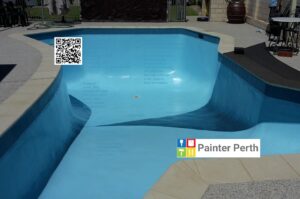How Often Does A Pool Need To Be Repainted?
Maintaining a pool isn’t an easy task, and repainting it shouldn’t be considered a small job. In order to keep your pool looking its best, you need to have a team of professionals come in to do the painting job. It’s important to choose painters like Painter Perth who can provide a safe and durable coating that is cost-effective and has good chemical resistance. A friendly team that uses top-quality materials will make your project hassle-free, but it’s important to know just how often you need to have your pool repainted. While there isn’t a one-size-fits-all answer, a typical pool will need to be repainted every five to seven years. This will help prevent the growth of bacteria and keeps the pool in hygienic conditions. In addition, repainting can prolong the life of your pool, saving you money in the long run. Overall, pool painting isn’t a DIY task and requires a knowledgeable and experienced painter to ensure the job is done correctly.
What Are The Benefits Of Using Epoxy Coatings?
Epoxy coatings offer numerous benefits that make them an ideal choice for a wide range of residential and commercial applications. Firstly, they enhance the durability of the substrate by providing a strong, resistant layer that can withstand even heavy traffic and harsh environmental conditions. Additionally, epoxy coatings are versatile enough to be applied to a variety of surfaces, ranging from concrete and metal to wood and tiles. With excellent chemical resistance and easy maintenance, these coatings can protect the surface from corrosion, abrasion and chemical damage, thereby increasing their lifespan. Furthermore, epoxy coatings provide an aesthetic appeal that can be customized to match any design or decor. They can be applied in various colours and textures, making them suitable for swimming pools, garage floors, driveways, and other areas where aesthetics are important. Plus, the installation of epoxy coatings is cost-effective, offering long-term savings due to their longevity and minimal maintenance requirements. Lastly, anti-slip properties can be incorporated into epoxy coatings to ensure safety in areas where slip-resistance is important.
Where Are Chlorine-resistant Materials Typically Used?
Chlorine-resistant materials are commonly used in various settings where exposure to harsh chemicals and environmental factors is a concern. In swimming pools, for instance, materials such as PVC, polypropylene, and epoxy are utilized in liners, filter media, and piping systems to withstand the corrosive effects of chlorine and other water treatment chemicals. Similarly, in water treatment plants and chemical processing facilities, corrosion-resistant materials like stainless steel, Hastelloy, and Teflon are integral to equipment and piping systems to ensure safe and efficient operations. In laboratories, chlorinated solvents and disinfectants necessitate the use of chlorine-resistant materials to protect instruments and surfaces from damage. Industrial manufacturing plants, marine environments, offshore oil rigs, and agricultural operations are other common areas where chlorine-resistant materials are used to prevent corrosion, prolong the lifespan, and prevent contamination. In essence, chlorine-resistant materials are critical components in ensuring a functional and safe environment where harsh chemicals and corrosive elements are present.
Are Non-slip Coatings Easy To Apply?
Non-slip coatings have become popular among homeowners and businesses seeking to improve safety in various areas such as bathrooms, patios, and pool decks. The ease of application of these coatings depends on the product chosen and the surface it will be applied to. An adequate surface preparation is necessary to ensure that the coating sticks properly and withstands daily wear and tear. Safety precautions should always be taken to avoid inhaling toxic fumes, and protective gear such as gloves and goggles should be used. The drying and curing time vary based on the product, but it is important to follow the manufacturer’s instructions to avoid any issues. Non-slip coatings vary in cost, but cheaper options may not last as long as more expensive products. Overall, the durability of these coatings is excellent, with some products lasting up to five years with proper maintenance. Cleaning and maintaining the coated surface may require special care, but this should not discourage one from using non-slip coatings. With proper application and maintenance, these coatings can significantly improve the safety of various surfaces, particularly in slippery areas.
What Are The Key Elements Of Pool Maintenance?
Pool maintenance involves several key elements to ensure that your pool remains clean and safe to use. One significant aspect of pool maintenance is monitoring water chemistry, which includes maintaining the pH balance and chlorine levels in the pool. It is also important to manage alkalinity to keep the water comfortable for swimmers. Skimming, brushing, and vacuuming the pool are essential maintenance activities to remove debris from the water surface and floor. Besides, filter cleaning must be carried out regularly to maintain the quality of the pool’s water. Another critical aspect of pool maintenance is conducting regular inspections to identify potential repairs and ensure that your pool is safe to use. Additionally, proper winterization is necessary to prepare your pool for the off-season. During this process, the pool’s water is drained, and the heater, pump, and filter are winterized to prevent damage. Lastly, pool owners must ensure that their pool’s coating is in good condition by working with professionals such as painter Perth to ensure that the coating remains intact. Maintaining your pool regularly will help you to prevent costly repairs and keep your pool operational year-round while ensuring the safety of swimmers.

